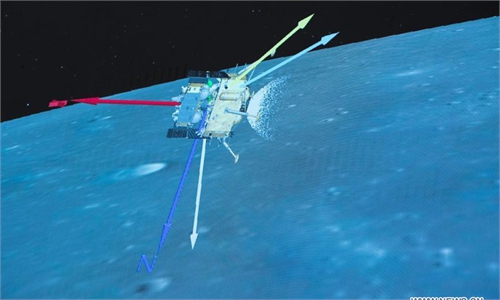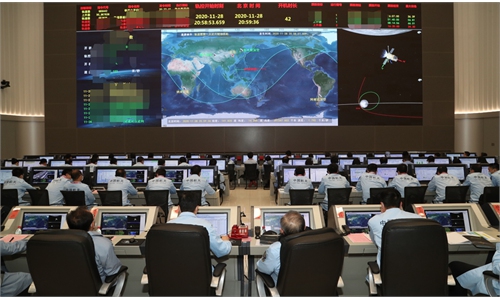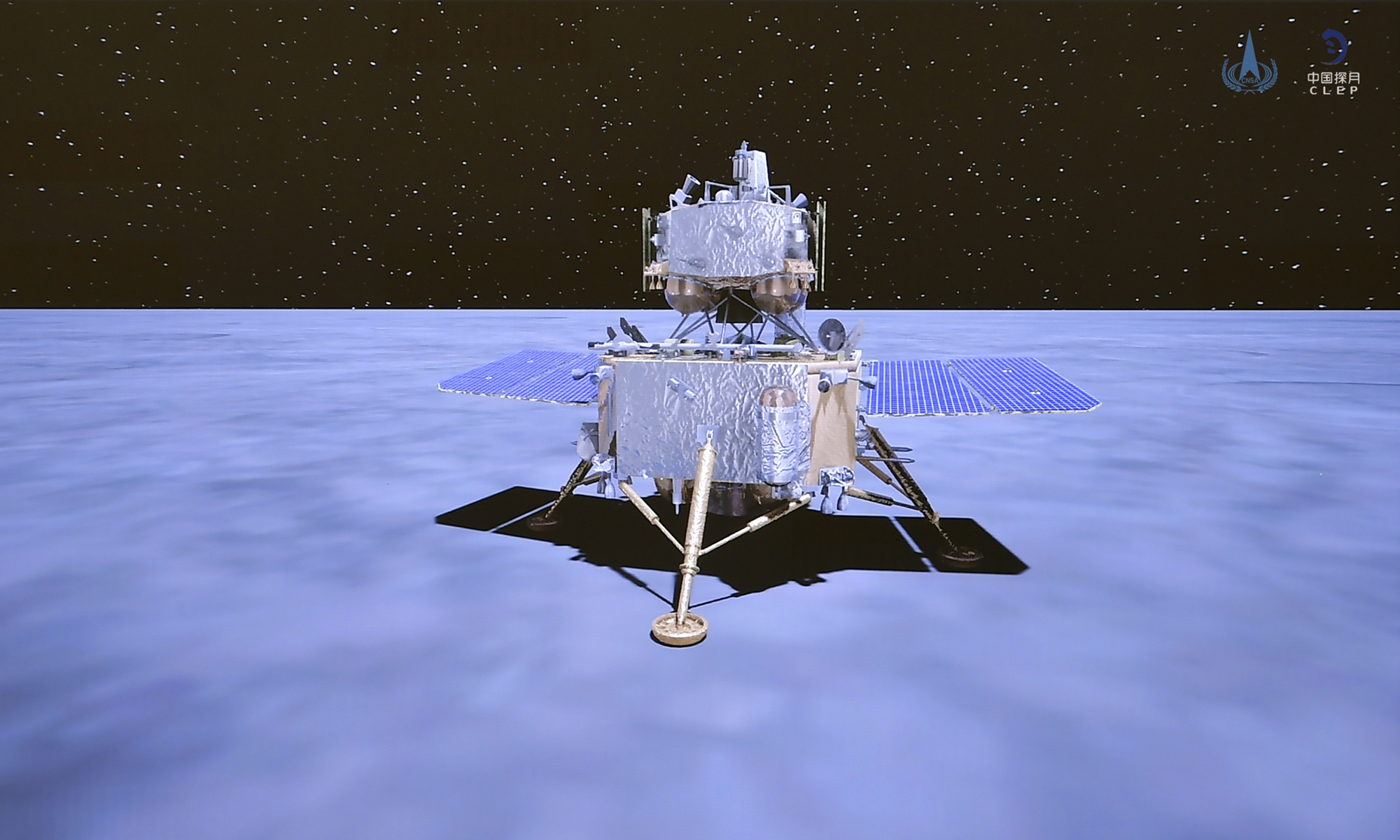
China's Chang'e-5 probe executed a successful landing on planned location on the moon 11:11 pm Tuesday Beijing time, sending images of operation. Photo: CNSA
Following a perfect landing on the designated area on the near side of the moon late Tuesday evening, the landing vehicle of Chinese robotic lunar probe Chang'e-5 officially began sample collecting work on the surface of Earth's celestial neighbor, according to the China National Space Administration (CNSA) on Wednesday.
The CNSA said in a statement sent to the Global Times that as of 4:53 am Wednesday, the lander-ascender combination of the Chang'e-5 probe had completed drilling the moon's surface and sealed the samples it had collected. The CNSA did not reveal the weight of the sample collected as of press time.
The Chang'e-5 uses a combination of a robotic arm and drilling equipment for its automatic and robotic sample collection from multiple points on the moon's surface and deeper ground, the CNSA said.
The surface sample collecting stage will take about two days, after which the ascender segment of the probe, carrying the sealed lunar samples, will take off from the moon to rendezvous and dock with the orbital module.
The re-entry capsule will then haul the moon dirt and rocks to Earth, with a touchdown planned in North China's Inner Mongolia Autonomous Region. The whole mission will last for 23 days, the CNSA said.
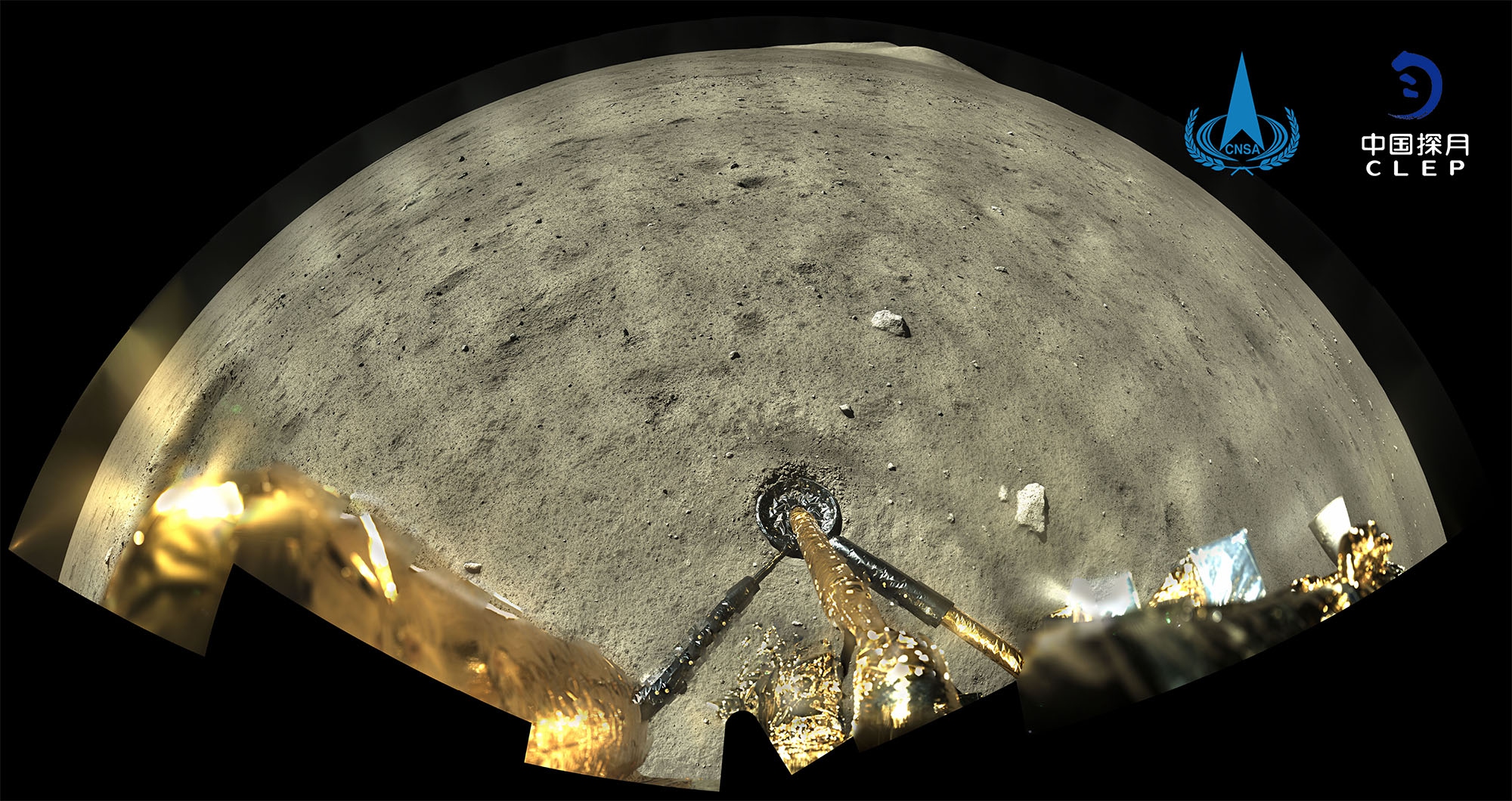
A panorama of the moon's surface by the lander-ascender combination of China’s Chang’e-5 probe after its smooth moon landing on Tue Photo: CNSA
Chang'e-5, the latest of China's increasingly complex lunar probe mission named after the moon goddess of Chinese mythology, aims to retrieve approximately two kilograms of rocks and dust and bring them back to Earth for scientific research and study.
To ensure the reliability and diversity of the sample collecting stage of the mission, designers from the China Academy of Space Technology (CAST), a subordinate of the state-owned aerospace giant China Aerospace Science and Technology Corporation (CASC), the landing vehicle is designed to collect surface dirt by gathering it with a robotic arm as well as digging into the moon surface with a cutting-edge drill.
Jiang Shuiqing, chief designer of the Chang'e-5 probe, said the Chinese spacecraft adopts an "automatic robotic" method in the surface operation stage, which is unique when compared to previous human lunar sample retrieval missions, and marked a world first.
The CAST designer team developed highly dexterous robotic arms for the lander vehicle. At the end of robotic arms are two types of samplers - one can perform scooping and the other one is capable of drilling up to 2 meters under the surface.
"Sample collection on a celestial body normally combines the scoop and the drill, since the materials on the surface are usually too complicated to analyze due to all kinds of space weathering effects, and it is the soil and rocks underground that are most valuable for studying," Wang Ya'nan, chief editor of Aerospace Knowledge magazine, told the Global Times.
The tubular samples, which will be taken from up to 2 meters deep, could provide a great amount of geological data, allowing for further studies on the material's content, causes, and time of formation.
Scientists believe that the landing site contains rocks and soil that are about 1.2 billion years old. It has never been visited either by a probe or human, and scientists believe it will fill an important gap in their understanding of the moon's volcanic activities.
The lunar material collected by the Chang'e-5 probe was formed from the space weathering of lunar rocks after meteorite impact, solar wind and cosmic ray radiation. It consists of a considerable amount of rock fragments, minerals and meteorites, which provide valuable information for studying the geological evolution of the moon, as well as solar activities, Xiao Long, a professor at the Wuhan-based China University of Geosciences, told the Global Times.
"Analysis of the lunar samples shows that contents within the soil and rocks could be turned into water and oxygen, which will be useful in supporting the operation of the moon base and serve as supplementary fuel for lunar landing vehicles," Pang Zhihao, a Beijing-based space expert, told the Global Times.
More importantly, scientists have found in the lunar samples the ideal material for nuclear fusion, and enough of it to meet mankind's energy needs for about 10,000 years, Pang added.
If successful, China will become the first country to bring moon materials back to Earth since 1976.
In the 1970s, the Soviet Union successfully carried out three robotic sample return missions that retrieved a total of 330 grams of lunar soil. The Chang'e-5 plans to bring back 2 kilograms in one single mission.
The gap in weight reflects how much the ability to retrieve lunar samples has advanced over the past decades, Pang Zhihao said.
He explained that back in the 1970s, the Soviet Union missions adopted a direct ascending and return plan from the lunar surface, which required the ascender to use large amounts of fuel to carry the huge load on the return capsule, resulting in the sample weight being greatly reduced.
The Chang'e-5, however, is expected to carry out rendezvous and docking with the orbital module in the lunar orbit, greatly reducing the amount of fuel needed for the ascender and allowing room for more samples.
The surface operation of the Chang'e-5 lander vehicle came after what insiders dubbed a "perfect" soft landing on the planned site earlier on Tuesday evening.
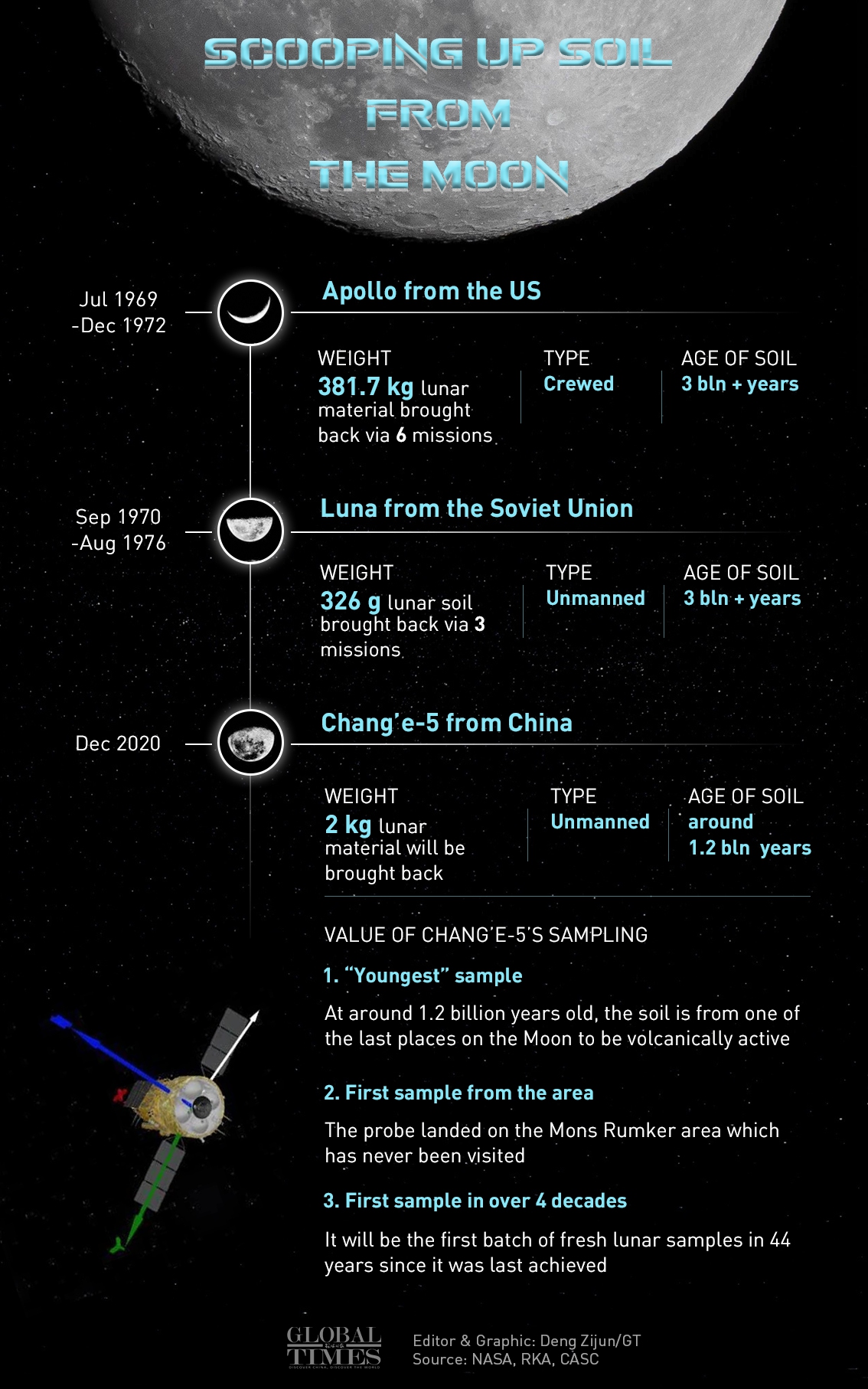
cover-Scooping up soil from the moon Photo: GT
According to CNSA, the exact location of the Chang'e-5 Tuesday landing was determined to be 51.8 degrees West longitude and 43.1 degrees North latitude on the near side of the moon, which is north of the Mons Rümker area of the huge volcanic plain Oceanus Procellarum, also known as the "Ocean of Storms."
The international community has been closely following the event.
"For the space program of China, this event is undoubtedly historic," Deputy Director General of Roscosmos Sergei Savelyev said in a statement, after congratulating his Chinese colleagues on behalf of the corporation.
"The study of the natural satellite of the Earth is currently one of the priority areas of space activities in all countries, and Russia and China regularly discuss the development of cooperation between our countries in this area," he added.
The European Space Agency (ESA) also extended a message of congratulations to CNSA upon its achievement.
The Associate Administrator for the Science Mission Directorate of US space agency NASA, Thomas Zurbuchen, wrote shortly after the landing event: "Congratulations to China on the successful landing of Chang'e 5."
"This is no easy task. When the samples collected on the Moon are returned to Earth, we hope everyone will benefit from being able to study this precious cargo that could advance the international science community," he wrote.
Chinese Foreign Ministry spokesperson Hua Chunying thanked Roscosmos, ESA, and other aerospace bodies for their congratulations to Chang'e-5 on Wednesday, and said that the mission marked a historic step for China to explore outer space, as well as a historic step for the world to deepen cooperation on this matter.
"China has been committed to a peaceful cooperation with the world on space exploration with an open mind, and we will share our achievements with other countries," Hua stressed.

